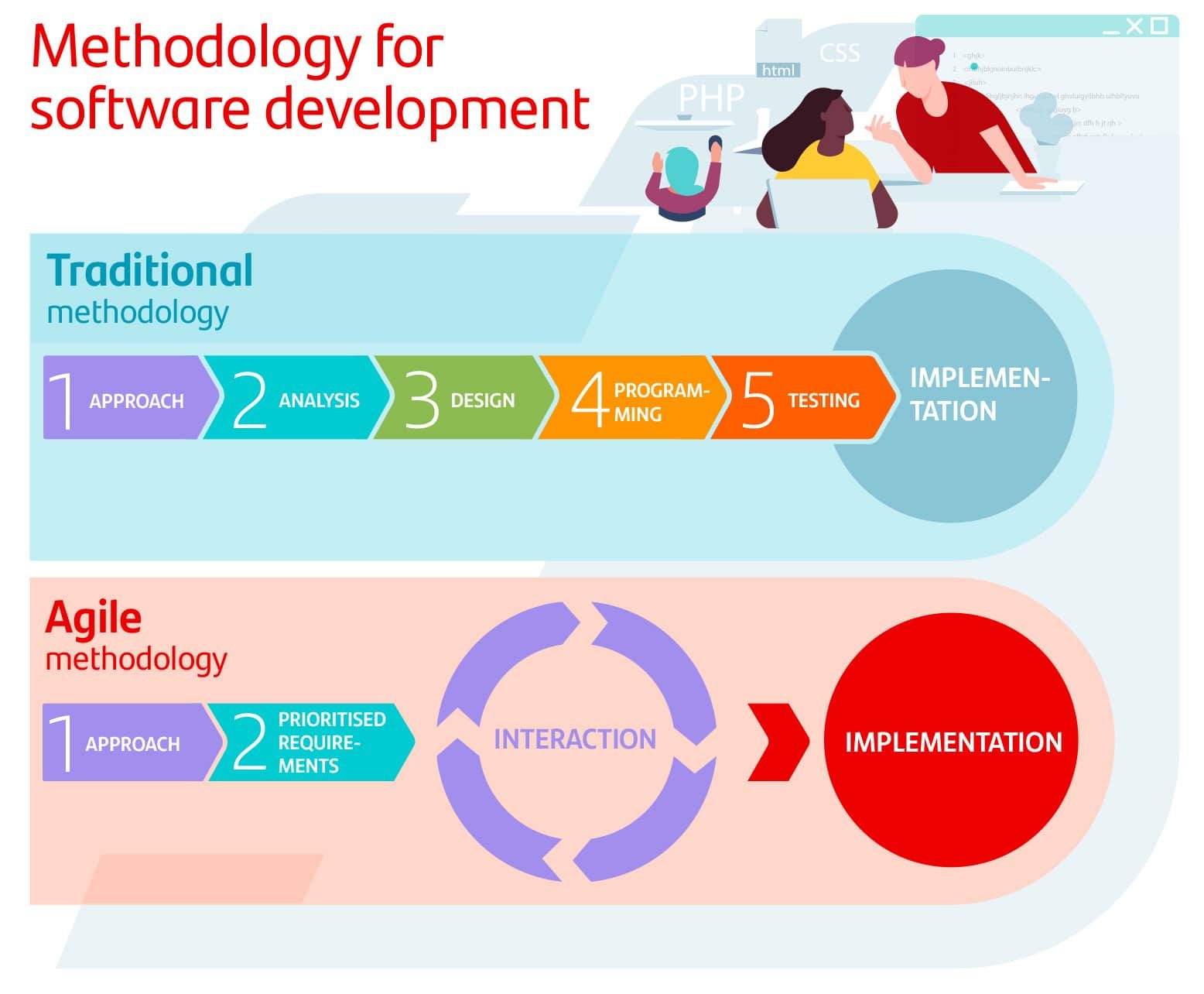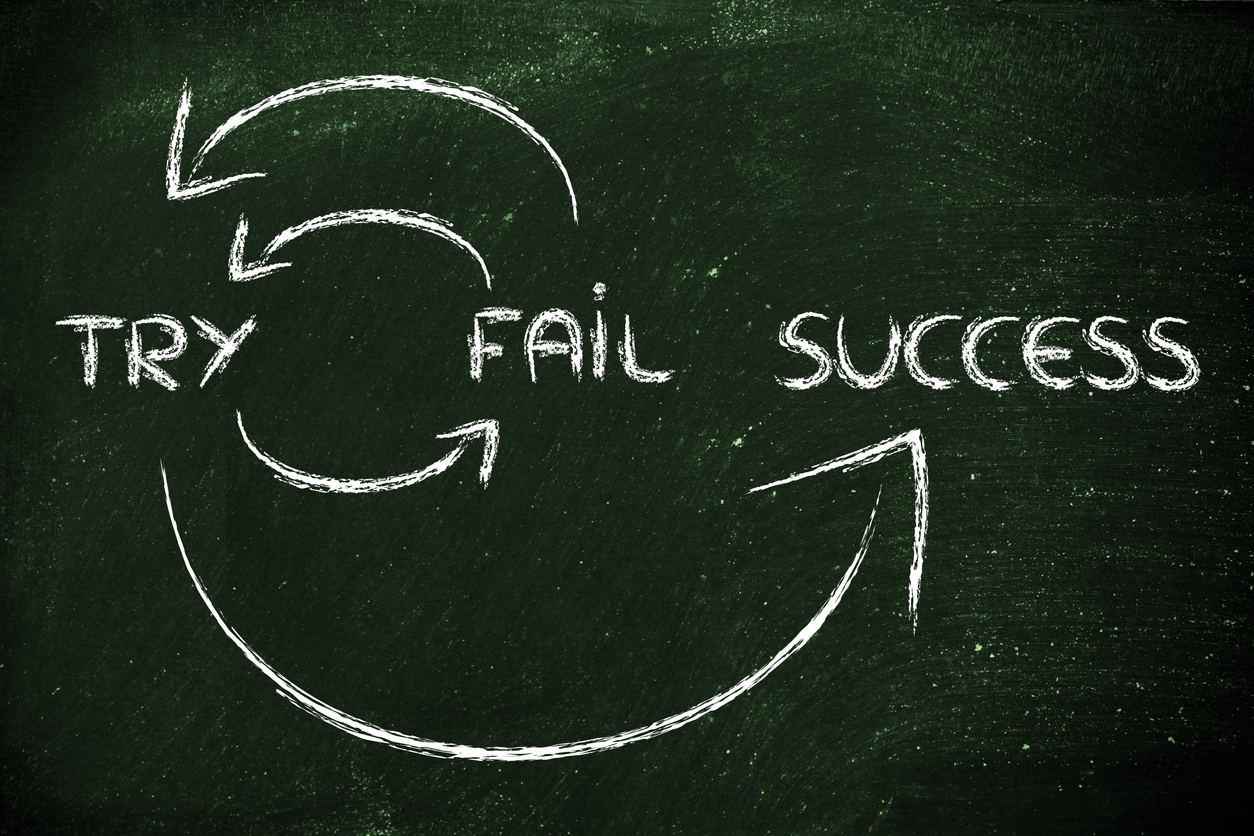Using a methodology for software developement
Methodology for software development is used in the field of programming, among others, with the aim of ensuring teams work in a more organised way. These methodologies have evolved over time, starting out as mere organisational procedures and becoming an important basis for the productive and effective development of software.
In recent decades, agile methodologies for software development have reigned supreme, as highlighted in the recent study by Project Manager Institute (PMI), which reveals that 71% of software engineering companies use such methodologies. Therefore, if you want to focus your career on software development, you will need to learn how agile methodologies work.
Some companies are still using traditional methodologies for software development, which may remain valid depending on the project and the company. In any event, using software development methodologies is imperative in the field of programming and the like, to create high-quality software.
What does a methodology for software development consist of?
Methodology for software development is a set of workflow techniques and methods that are harnessed to design I.T. software solutions. The aim of the various methodologies is to organise teams so that these can develop the program features in the best possible way.

When it comes to developing products or solutions for a specific client or market, it's important to bear in mind factors such as costs, planning, difficulties, the available team, the languages used, etc. All of this forms part of a development methodology that allows the work to be organised optimally.
Software development is often an especially complex sector, above all when dealing with major applications and work teams. Setting out to develop a product without clear methodology will only lead to a more complex process, as well as problems, delays, errors and, ultimately, a poor final result.
Using a methodology for software development helps reduce the level of difficulty, organise tasks, streamline processes and improve the final outcome of the applications to be developed.

What different types of methodologies for software development are there?
At present, there are two broad groups of methodologies for software development: agile and traditional. Below, we explain the features of each one.
Traditional methodologies for software development
Traditional methodologies for software development are characterised by fully and strictly setting out the requirements at the start of software engineering projects. Development cycles are not particularly flexible and do not allow changes to be made, unlike agile methodologies, which has led to an increase in use of the latter.
Work flow under the traditional methodologies is linear, i.e., the stages come one after another and the next can't begin until the previous is finished. It's also not possible to jump backwards once you move on to a new stage. These methodologies adapt poorly to change, yet the present world is changing constantly. The main traditional or classic methodologies are:
- Waterfall: this is a methodology in which the stages are organised top down, hence the name. The various functions are developed in different stages and follow a strict order. Before each stage, it's vital to check the product to see if it's ready to move on to the next phase. Initial requirements and specifications are not meant to be changed, meaning the results can not be seen until the project is already fairly advanced.
- Prototyping: based on the construction of a software prototype that is built quickly, so that users can test it and provide feedback. In this way, bugs can be fixed and other requirements that may arise can be added on. This is an iterative model based on trial-and-error methodology to understand product specificities.
- Spiral: a combination of the two previous models, which adds the concept of risk analysis. It is divided into four stages: planning, risk analysis, prototype development and customer evaluation. This methodology is named for how it functions, as the stages are approached in a spiral format. The closer to the centre, the more advanced the project is.
- Incremental: in this methodology for software development, the final product is built progressively. A new functionality is added at each incremental stage, allowing the results to be seen more quickly compared to the waterfall model. The software can be used even before it's fully complete and, in general, it is much more flexible than the other methodologies.
- Rapid Application Development (RAD): this methodology allows high quality software to be developed in a short period of time. Involving much higher costs and more flexible development, this model, however, requires greater user intervention. Meanwhile, the code might contain more errors, and its functions are limited due to little time being devoted to developing them. The goal is to iterate as few times as possible, thus developing a complete application quick-fast.
Agile methodologies for software development
As we said at the start of the article, agile methodologies for software development are the most commonly used today, thanks to their flexibility and agility. Teams using these are far more productive and efficient, as they know exactly what they have to do at any given time. Moreover, the methodology allows the software to adapt to needs that arise along the way, thus making it easier to build more functional applications.
Agile methodologies are based on incremental methodology, in which new functionalities are added to the final application in each development cycle. However, these cycles are much shorter and faster, hence small features are added in instead of major changes.
This type of methodology allows self-sufficient and independent work teams to be built, which meet often to share the latest updates. Bit by bit, the final product is built and polished, while the client can add new requirements or corrections thanks to being able to follow the project in real-time.
The main agile methodologies are:
- Kanban: a framework invented by the car company Toyota. It involves dividing tasks into minimal chunks and organising these on a work board divided into pending, ongoing and completed tasks. This creates a very visual work flow based on priority tasks and increasing the product value.
- Scrum: also an incremental methodology, which divides the requirements and tasks in a similar way to Kanban. Completed over short, time-boxed iterations (from 2 to 4 weeks) to achieve a complete result in each iteration. Each iteration through these stages is also known as a sprint, therefore the stages are: planning sprint, sprint, daily meeting, and sprint review.
- Lean: set up so that small, highly trained development teams can perform any task in a short time. The most important assets are the people and their commitment, with time and costs being relegated to the background. Learning, quick responses and bolstering the team are all fundamental.
- Extreme Programming (XP): this methodology for software development is based on interpersonal relationships, which are considered key to success. Its main aim is to create a good teamwork environment and for there to be constant feedback from the client. Work is based on 12 concepts: simplicity, testing, refactoring and coding with standards, collective code ownership, pair programming, continuous integration, weekly delivery and integrity with the customer, on-site customer, frequent delivery and planning.

Developing high quality software: the present and future of everything we already know
Software development has become one of the most important activities in modern society. In a world where artificial intelligence and technology form a basic part of our lives, developing safe, high-quality software is only set to become more important.
To be one of the professionals who make this process possible, you need to have the right know-how. That's why Banco Santander is launching various initiatives for those who want to train or refocus their career towards the sector with the most in-demand jobs right now.
Would you like to develop your skills and competences in the digital and technological field? If you're the type of person who never stops learning, and want to boost your knowledge in areas such as leadership, business, management, personal development, digital transformation, soft skills, sustainability and much more, then at Learning Room, the new content platform by Santander Open Academy, you can enjoy four free content items a month - in addition to all the other free content. By simply registering, you will have access to hundreds of contents in formats such as eBooks, podcasts, audiobooks, courses and videos. If you like what you're reading, then come on over.

More interesting posts to read...
-
 12/04/2024 | Santander Universidades
12/04/2024 | Santander UniversidadesGrowth mindset: examples in the workplace to develop the right attitude toward challenges
Card text -
 01/03/2024 | Santander Universidades
01/03/2024 | Santander UniversidadesThe sandwich technique: how to deliver criticism in an assertive way
Card text